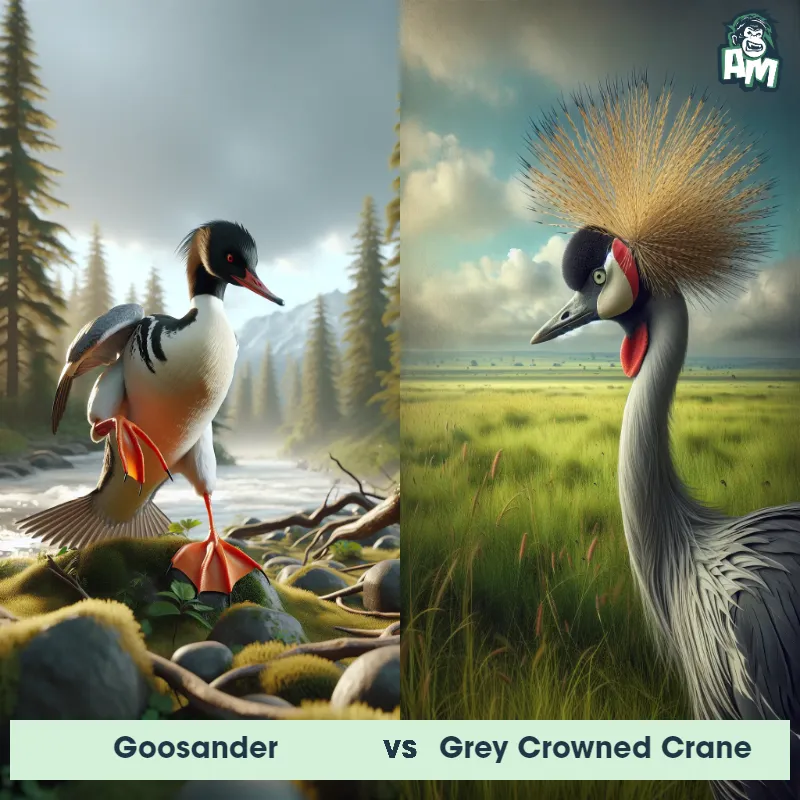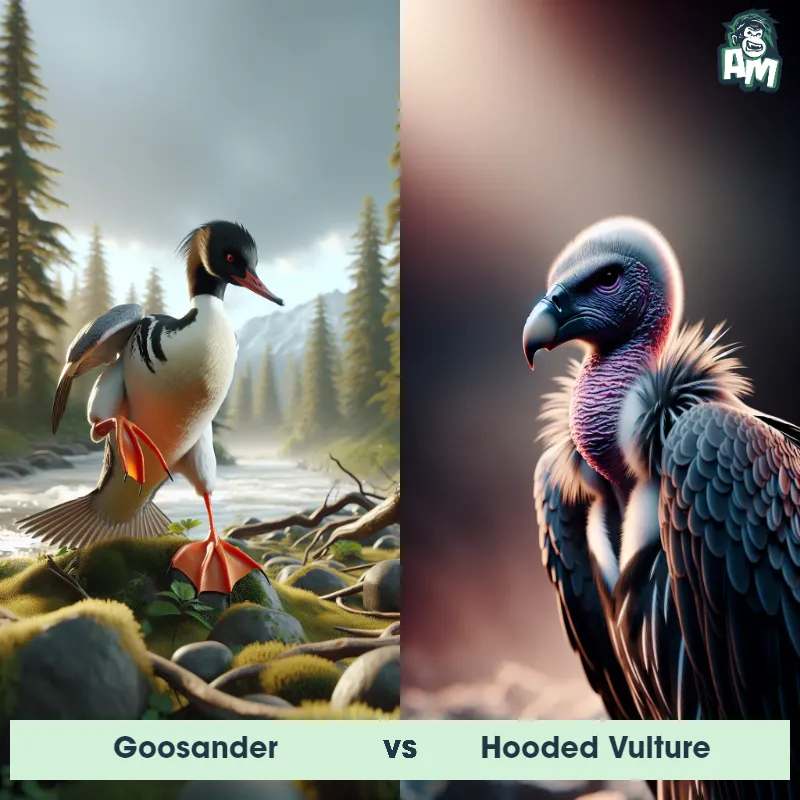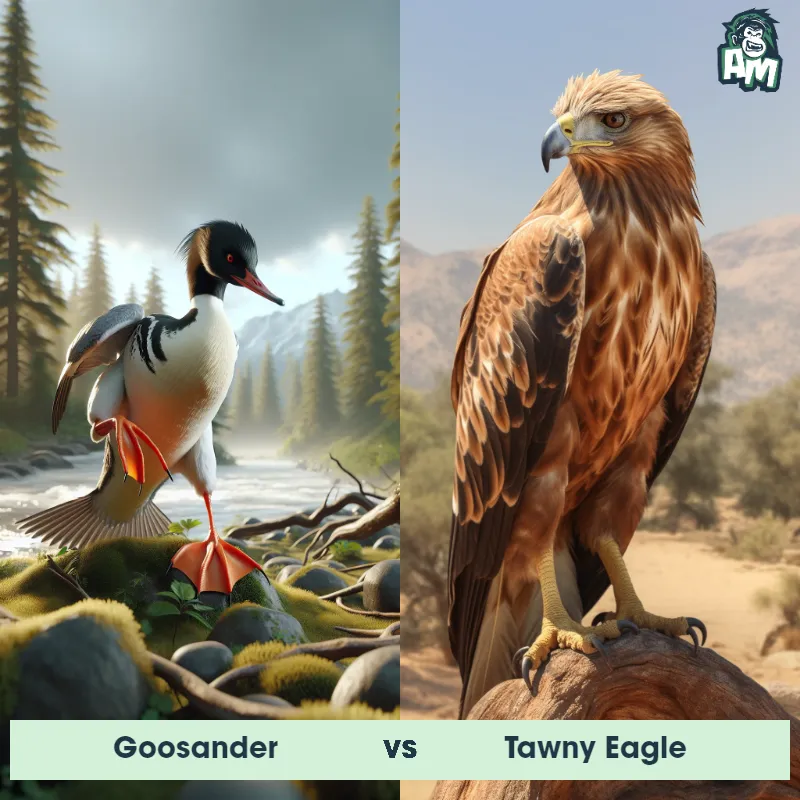The Goosander
The Goosander, also known as the Common Merganser, is a large diving duck species that belongs to the Anatidae family. These beautiful birds are known for their sleek and streamlined bodies, with males having a black and white coloration, while females have a grayish-brown feathers. They have long slender bills equipped with serrated edges, perfect for catching and gripping slippery fish, which is their primary diet. Goosanders have excellent diving abilities, able to submerge underwater for extended periods in search of prey. They are primarily found in freshwater habitats across Europe, Asia, and North America.

| Goosander | |
|---|---|
| Size | 24-28 inches (61-71 cm) in length |
| Weight | 2.2-4.4 pounds (1-2 kg) |
| Speed | 50mph (80km/h) |
| Key Strength | Agility in water |
| Biggest Weakness | Vulnerable on land |
| Scientific Name | Mergus merganser |
| Family | Anatidae |
| Habitat | Lakes, rivers, and estuaries |
| Geography | Native to Europe and North America |
| Diet | Fish, amphibians, and small crustaceans |
| Lifespan | 10 years - 15 years |

The Goosander
The Goosander, also known as the Common Merganser, is a large diving duck species that belongs to the Anatidae family. These beautiful birds are known for their sleek and streamlined bodies, with males having a black and white coloration, while females have a grayish-brown feathers. They have long slender bills equipped with serrated edges, perfect for catching and gripping slippery fish, which is their primary diet. Goosanders have excellent diving abilities, able to submerge underwater for extended periods in search of prey. They are primarily found in freshwater habitats across Europe, Asia, and North America.
Fun Fact: One fun fact about Goosanders is that they have the unique ability to swim underwater using their webbed feet like paddles, allowing them to reach impressive speeds while hunting for fish.
| Goosander | |
|---|---|
| Size | 24-28 inches (61-71 cm) in length |
| Weight | 2.2-4.4 pounds (1-2 kg) |
| Speed | 50mph (80km/h) |
| Key Strength | Agility in water |
| Biggest Weakness | Vulnerable on land |
| Scientific Name | Mergus merganser |
| Family | Anatidae |
| Habitat | Lakes, rivers, and estuaries |
| Geography | Native to Europe and North America |
| Diet | Fish, amphibians, and small crustaceans |
| Lifespan | 10 years - 15 years |
Goosander Matchups
We use AI to simulate matchups between the Goosander and other animals. Our simulation considers size, strength, and natural predatory behaviors to determine the most likely outcome.

Can't find the Matchup you want?
Create Your Own MatchupGoosander: Diet, Predators, Aggression, and Defensive Behaviors
What do Goosanders eat?
Goosanders primarily feed on fish, such as salmon, trout, and other small freshwater fish. They are skilled divers and swimmers, using their serrated bills to catch their prey underwater.
Do Goosanders have any predators?
Yes, Goosanders face predation from larger birds of prey, such as eagles and hawks, which may target both juvenile and adult birds. Additionally, foxes, minks, and other small mammals may also prey on Goosander eggs and chicks.
Are Goosanders aggressive?
Goosanders are generally not aggressive towards humans but can display aggression towards other birds during breeding season or when competing for food. They may also exhibit territorial behavior and aggression towards perceived threats to their nesting sites.
Do Goosanders fight?
Male Goosanders may engage in territorial disputes and fights with rival males during breeding season. These fights can involve displays of aggression, such as bill-snapping and physical clashes, to establish dominance and access to females.
How do Goosanders defend themselves?
Goosanders rely on their agility and diving abilities to evade predators. They are also known to give alarm calls and exhibit warning behaviors, such as raising their crests and flapping their wings, to alert others in their group of potential threats.
What is the Goosander's biggest weakness in a fight?
One of the Goosander's biggest weaknesses in a fight is their vulnerability during nesting and breeding season. Adult birds may be more focused on protecting their nests and offspring, making them susceptible to attacks from predators or rival males seeking to challenge their territory.
Fun Fact: Goosanders are highly social birds and often form small groups or large flocks during the non-breeding season, making them a fabulous sight to behold, especially when in flight as they fly in tight formations.
Fun Fact: During courtship displays, male Goosanders put on an impressive show, stretching their necks upwards and rapidly shaking their heads from side to side while emitting low, repeated calls. This mesmerizing behavior serves to attract the attention of potential mates.













